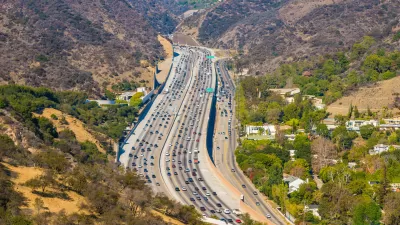Jeremy Rosenberg's latest entry in his "Laws That Shaped LA" column looks at the impact of the Collier-Burns Act, a state law passed in 1947 that allowed the city to become "smothered with concrete and asphalt goliaths."
Intended to relieve growing urban traffic congestion, the Collier-Burns Act created the bureaucratic and funding mechanisms that sparked "a local, regional, and nationwide road-building frenzy that
began in the 1940s and '50s and hasn't yet come to a full and complete
stop," writes Rosenberg.
"Collier-Burns raised the fuel tax by 50%, vehicle registration fees
by 200%, and in a maneuver with an efficacy that should never go
underestimated, centralized bureaucratic power in one agency -- the
California Division of Highways (which later became Caltrans)."
"The Collier-Burns legacy? Within just five years after the Act's passing, the Golden State increased its freeway mileage by four and a half times. Prior to Collier-Burns, many Californians -- and Los Angelenos in
particular -- had worked towards developing a multi-modal highway system
with a relatively limited footprint inside cities, left the mega-roads
we know today for more spacious rural routes, and incorporated and
expanded public transit."
"Instead, catalyzed by the Collier-Burns-inspired highway funding
spigot, with the 1956 Federal-Aid Highway Act (more about this in a
future Laws That Shaped LA column), cities received a Godfather-style offer they couldn't refuse: money, and lots of it, to build freeways, lots of them."
FULL STORY: My Way Or The Highway: Why Mega-Roads Rule The City

Alabama: Trump Terminates Settlements for Black Communities Harmed By Raw Sewage
Trump deemed the landmark civil rights agreement “illegal DEI and environmental justice policy.”

Study: Maui’s Plan to Convert Vacation Rentals to Long-Term Housing Could Cause Nearly $1 Billion Economic Loss
The plan would reduce visitor accommodation by 25% resulting in 1,900 jobs lost.

Planetizen Federal Action Tracker
A weekly monitor of how Trump’s orders and actions are impacting planners and planning in America.

Federal Homelessness Agency Places Entire Staff on Leave
The U.S. Interagency Council on Homelessness is the only federal agency dedicated to preventing and ending homelessness.

Restoring Northern India’s Himalayan ‘Water Temples’
Thousands of centuries-old buildings protect the region’s natural springs and serve as community wells and gathering places.

Milwaukee to Double Bike Share Stations
Bublr Bikes, one of the nation’s most successful, will add 500 new e-bikes to its system.
Urban Design for Planners 1: Software Tools
This six-course series explores essential urban design concepts using open source software and equips planners with the tools they need to participate fully in the urban design process.
Planning for Universal Design
Learn the tools for implementing Universal Design in planning regulations.
Caltrans
Smith Gee Studio
Institute for Housing and Urban Development Studies (IHS)
City of Grandview
Harvard GSD Executive Education
Toledo-Lucas County Plan Commissions
Salt Lake City
NYU Wagner Graduate School of Public Service




























